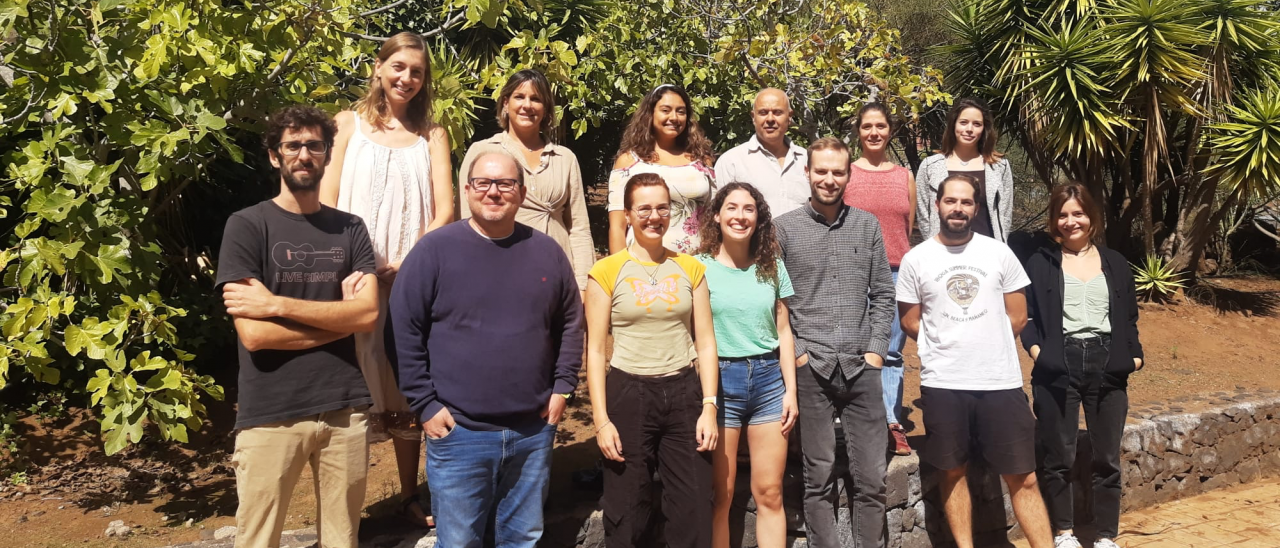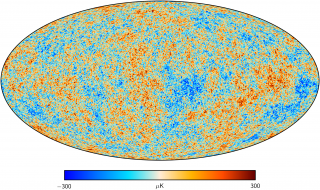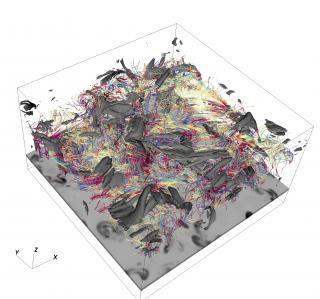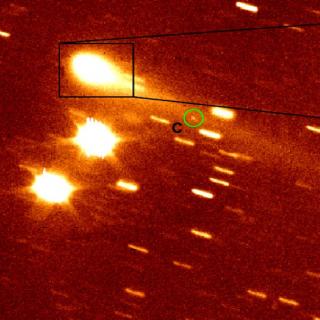Subvenciones relacionadas:
General
Bienvenida a la página web del grupo de investigación Traces of Galaxy Formation.
Somos un grupo de investigación amplio, diverso y muy activo cuyo objetivo principal es entender la formación de galaxias en el Universo de una manera lo más completa posible. Con el estudio detellado de las poblaciones estelares como bandera, estamos constantemente buscando y desarrollando nuevas herramientas e ideas que nos permitan entender cómo las galaxias han llegado a convertirse en lo que hoy observamos.
Una historia de formación compleja, como la que se espera describa la evolución de las galaxias, necesita de un acercamiento multidisciplinar para ser entendida. Nuestro grupo en el IAC está compuesto por personal investigador de gran experiencia en simulaciones cosmológicas, estudios dinámicos, análisis de poblaciones estelares y caracterizaciones morfológicas de galaxias tanto locales como a alto corrimiento al rojo. Combinamos distintas alternativas (e.g. observaciones y teoría o procesos de evolución secular y cosmológica) para poder alcanzar en los próximos años una visión consistente de los mecanismos físicos que regulan la formación de las galaxias.
Dentro de este esquema general, estamos principalmente centrados en el estudio de tres líneas centrales:
- Modelos de síntesis de poblaciones estelares
- Desarrollo de modelos de poblaciones estelares
- Métodos de análisis para el estudio de poblaciones estelares
- Universalidad de la función inicial de masa (IMF)
- Evolución cósmica de galaxias
- Evolución de galaxias masivas
- Poblaciones estelares en distintos entornos
- Ciencia a bajo brillo superficial
- Simulaciones númericas y aprendizaje automático
- Procesos evolutivos en galaxias cercanas
- Agujeros negros como moduladores de la formación estelar
- Cartogrtafiados locales
- Cinemática estelar y modelos dinámicos
Si quieres ponerte en contacto o trabajar con el grupo, por favor, envía un correo al investigador principal (Ignacio Martín-Navarro ignacio.martin [at] iac.es (ignacio[dot]martin[at]iac[dot]es)).
Miembros
Resultados
Esta es una muestra de algunos de nuestros resultados destacados más recientes:
- Local variations of the stellar velocity ellipsoid - II. The effect of the bar in the inner regions of Auriga galaxies. Walo et al. 2022, MNRAS (https://ui.adsabs.harvard.edu/abs/2022MNRAS.513.4587W)
- Anisotropic satellite galaxy quenching modulated by black hole activity. Martín-Navarro et al. 2021, Nature (https://ui.adsabs.harvard.edu/abs/2021Natur.594..187M)
- Evaluating hydrodynamical simulations with green valley galaxies. Angthopo et al. 2021, MNRAS (https://ui.adsabs.harvard.edu/abs/2021MNRAS.502.3685A)
- Sub one per cent mass fractions of young stars in red massive galaxies. Salvador-Rusiñol et al. 2020, Nature Astronomy (https://ui.adsabs.harvard.edu/abs/2020NatAs...4..252S)
- Detection of young stellar populations in apparently quenched low-mass galaxies using red spectral line indices. de Lorenzo-Cáceres et al. 2020, MNRAS (https://ui.adsabs.harvard.edu/abs/2020MNRAS.498.1002D)
Actividad científica
Publicaciones relacionadas
-
The survival of stellar discs in Fornax-like environments, from TNG50 to real galaxiesWe study the evolution of kinematically defined stellar discs in 10 Fornax-like clusters identified in the TNG50 run from the IllustrisTNG suite of cosmological simulations. We considered disc galaxies with present-day stellar mass M ⋆ ≥ 3 × 10 8 M ⊙ and follow their evolution since first entering their host cluster. Very few stellar discs surviveGalán-de Anta, Pablo M. et al.
Fecha de publicación:
122022 -
EMIR, the near-infrared camera and multi-object spectrograph for the GTC. EMIR at GTCWe present EMIR, a powerful near-infrared (NIR) camera and multi-object spectrograph (MOS) installed at the Nasmyth focus of the 10.4 m GTC. EMIR was commissioned in mid-2016 and is offered as a common-user instrument. It provides spectral coverage of 0.9-2.5 µm over a field of view (FOV) of 6.67' × 6.67' in imaging mode, and 6.67' × 4' inGarzón, F. et al.
Fecha de publicación:
112022 -
The SAMI-Fornax Dwarfs Survey - II. The Stellar Mass Fundamental Plane and the dark matter fraction of dwarf galaxiesWe explore the kinematic scaling relations of 38 dwarf galaxies in the Fornax Cluster using observations from the SAMI integral field spectrograph. We focus on the Fundamental Plane (FP), defined by the physical properties of the objects (scale length, surface brightness, and velocity dispersion) and the Stellar Mass (Fundamental) Plane, whereEftekhari, F. Sara et al.
Fecha de publicación:
122022 -
The edges of galaxies: Tracing the limits of star formationThe outskirts of galaxies have been studied from multiple perspectives for the past few decades. However, it is still unknown if all galaxies have clear-cut edges similar to everyday objects. We address this question by developing physically motivated criteria to define the edges of galaxies. Based on the gas density threshold required for starChamba, Nushkia et al.
Fecha de publicación:
112022 -
Non-Gaussianity of optical emission lines in SDSS star-forming galaxies and its implications on galactic outflowsThe shape of emission lines in the optical spectra of star-forming galaxies reveals the kinematics of the diffuse gaseous component. We analyse the shape of prominent emission lines in a sample of $∼$ 53000 star-forming galaxies from the Sloan Digital Sky Survey, focusing on departures from gaussianity. Departures from a single gaussian profileYu, B. P. Brian et al.
Fecha de publicación:
112022 -
The stellar populations of quiescent ultra-diffuse galaxies from optical to mid-infrared spectral energy distribution fittingWe use spectral energy distribution (SED) fitting to place constraints on the stellar population properties of 29 quiescent ultra-diffuse galaxies (UDGs) across different environments. We use the fully Bayesian routine PROSPECTOR coupled with archival data in the optical, near, and mid-infrared from Spitzer and Wide-field Infrared Survey ExplorerBuzzo, Maria Luisa et al.
Fecha de publicación:
122022 -
On the accretion of a new group of galaxies on to Virgo - II. The effect of pre-processing on the stellar population content of dEsUsing MUSE spectra, we investigate how pre-processing and accretion on to a galaxy cluster affect the integrated stellar population properties of dwarf early-type galaxies (dEs). We analyse a sample of nine dEs with stellar masses of $\rm \sim 10^9 \, M_\odot$, which were accreted (~ 2-3 Gyr ago) on to the Virgo cluster as members of a massiveBidaran, Bahar et al.
Fecha de publicación:
92022 -
Non-solar abundance ratios trends of dEs in the Fornax Cluster using newly defined high-resolution indicesWe perform a detailed study of the stellar populations in a sample of massive Fornax dwarf galaxies using a set of newly defined line indices. Using data from the Integral Field Spectroscopic data, we study abundance ratios of eight dEs with stellar mass ranging from 10 8 to 10 9.5 M ⊙ in the Fornax Cluster. We present the definitions of a new setŞen, Şeyda et al.
Fecha de publicación:
92022 -
The Fornax3D project: Discovery of ancient massive merger events in the Fornax cluster galaxies NGC 1380 and NGC 1427We report the discovery of ancient massive merger events in the early-type galaxies NGC 1380 and NGC 1427, members of the Fornax galaxy cluster. Both galaxies have been observed by the MUSE integral-field-unit instrument on the VLT as part of the Fornax3D project. By fitting recently developed population-orbital superposition models to the observedZhu, Ling et al.
Fecha de publicación:
82022 -
Lessons from the massive relic NGC 1277: Remaining in situstar formation in the cores of massive galaxiesNear-ultraviolet (NUV) spectroscopic studies have suggested that passively evolving massive, early-type galaxies host sub-one per cent fractions of young stars in their innermost regions. We shed light on the origin of these stars by analysing NGC 1277, a widely studied nearby prototypical massive compact relic galaxy. These are rare galaxies thatSalvador-Rusiñol, N. et al.
Fecha de publicación:
92022 -
Fornax3D project: Assembly history of massive early-type galaxies in the Fornax cluster from deep imaging and integral field spectroscopyThis work is based on high-quality integral-field spectroscopic data obtained with the Multi Unit Spectroscopic Explorer (MUSE) on the Very Large Telescope (VLT). The 21 brightest (m B ≤ 15 mag) early-type galaxies (ETGs) inside the virial radius of the Fornax cluster are observed out to distances of ∼2−3 R e. Deep imaging from the VLT SurveySpavone, M. et al.
Fecha de publicación:
72022 -
The relic galaxy NGC 1277 rules out intermediate-age stellar populations origin of CO-strong absorptions in massive early-type galaxiesMassive early-type galaxies (ETGs) show several strong CO absorption features in their H- and K-band spectra that cannot be explained by state-of-the-art stellar population models. For many years, the disagreement has been attributed to the presence of intermediate-age stellar components that are dominated by stars in the asymptotic giant branchEftekhari, Elham et al.
Fecha de publicación:
92022 -
Testing the role of AGN on the star formation and metal enrichment of 'twin galaxies'We explore the effect of AGN activity on the star formation history of galaxies by analysing the stellar population properties of 10 pairs of nearby twin galaxies - selected as being visually similar except for the presence of an AGN. The selection of such twin samples represents a method to study AGN feedback, as recently proposed by del MoralAngthopo, J. et al.
Fecha de publicación:
92022 -
The black hole population in low-mass galaxies in large-scale cosmological simulationsRecent systematic searches for massive black holes (BHs) in local dwarf galaxies led to the discovery of a population of faint active galactic nuclei (AGNs). We investigate the agreement of the BH and AGN populations in the Illustris, TNG, Horizon-AGN, EAGLE, and SIMBA simulations with current observational constraints in low-mass galaxies. We findHaidar, Houda et al.
Fecha de publicación:
82022 -
The Fornax3D project: intrinsic correlations between orbital properties and the stellar initial mass functionVariations of the stellar initial mass function (IMF) in external galaxies have been inferred from a variety of independent probes. Yet the physical conditions causing these variations remain largely unknown. In this work, we explore new spatially resolved measurements of the IMF for three edge-on lenticular galaxies in the Fornax cluster. WePoci, A. et al.
Fecha de publicación:
82022 -
Local variations of the stellar velocity ellipsoid - II. The effect of the bar in the inner regions of Auriga galaxiesTheoretical works have shown that off-plane motions of bars can heat stars in the vertical direction during buckling but is not clear how do they affect the rest of components of the stellar velocity ellipsoid (SVE). We study the 2D spatial distribution of the vertical, σ z, azimuthal, σ ϕ, and radial, σ r velocity dispersions in the inner regionsWalo-Martín, Daniel et al.
Fecha de publicación:
72022 -
Modelling simple stellar populations in the near-ultraviolet to near-infrared with the X-shooter Spectral Library (XSL)We present simple stellar population models based on the empirical X-shooter Spectral Library (XSL) from near-ultraviolet (NUV) to near-infrared (NIR) wavelengths. The unmatched characteristics of the relatively high resolution and extended wavelength coverage (350-2480 nm, R ∼ 10 000) of the XSL population models bring us closer to bridgingVerro, K. et al.
Fecha de publicación:
52022 -
The Fornax3D project: The environmental impact on gas metallicity gradients in Fornax cluster galaxiesThe role played by environment in galaxy evolution is a topic of ongoing debate among astronomers. There has been little success in elucidating the degree to which environment can alter, re-shape, or drive galaxy evolution, that is, using either observations or simulations. However, our knowledge of the effect of environment on gas metallicityLara-López, M. A. et al.
Fecha de publicación:
42022 -
From Naked Spheroids to Disky Galaxies: How Do Massive Disk Galaxies Shape Their Morphology?We investigate the assembly history of massive disk galaxies and describe how they shape their morphology through cosmic time. Using SHARDS and HST data, we modeled the surface brightness distribution of 91 massive galaxies at redshift 0.14 < z ≤ 1 in the wavelength range 0.5-1.6 μm, deriving the uncontaminated spectral energy distributions ofCostantin, Luca et al.
Fecha de publicación:
42022 -
The X-shooter Spectral Library (XSL): Data Release 3We present the third data release (DR3) of the X-shooter Spectral Library (XSL). This moderate-to-high resolution, near-ultraviolet-to-near-infrared (350-2480 nm, R ∼ 10 000) spectral library is composed of 830 stellar spectra of 683 stars. DR3 improves upon the previous data release by providing the combined de-reddened spectra of the three XVerro, K. et al.
Fecha de publicación:
42022



